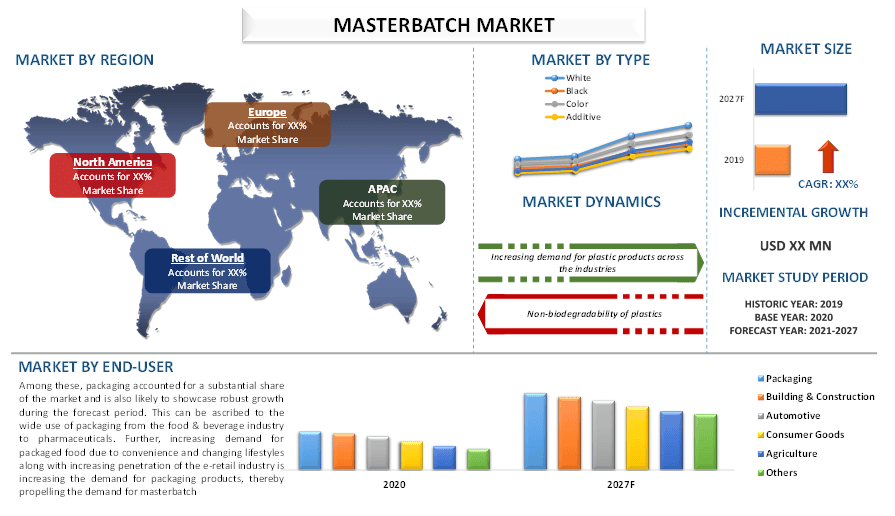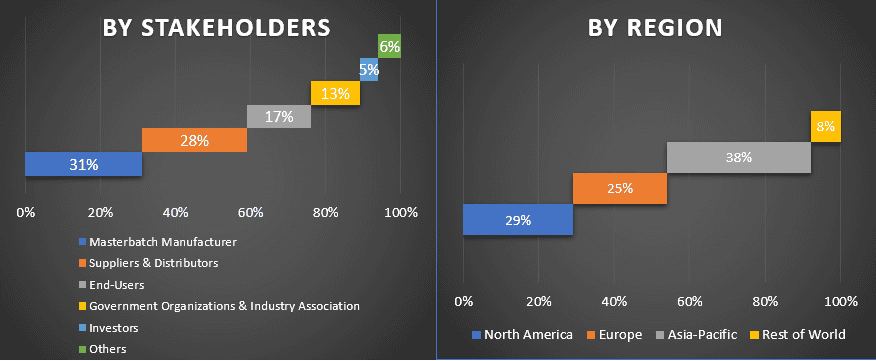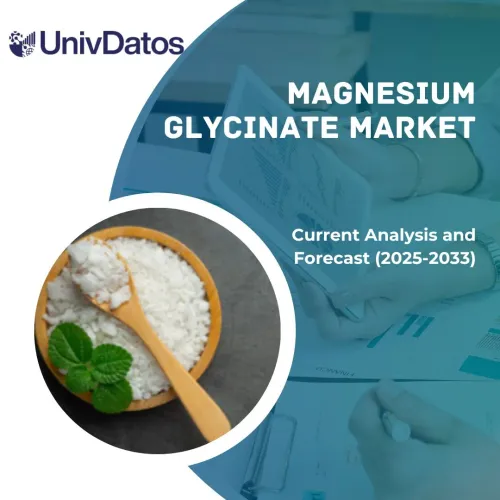- Home
- About Us
- Industry
- Services
- Reading
- Contact Us
Masterbatch Market: Current Analysis and Forecast (2021-2027)
Emphasis on Type (White, Black, Color, Additive, and Filler/Combination); Polymer (PP, PE, PVC, PET, and Others); End-User (Packaging, Building & Construction, Automotive, Consumer Goods, Agriculture, and Others); and Region and Country

The global masterbatch market is likely to showcase a growth of around 5% during the forecast period. Nowadays, consumers are increasingly conscious of the products they buy and the value they get. Products that are reliable and durable naturally attract more attention. And most products, whether it is the cars, the packaging, the houses, the gadgets, and even healthcare, consumers use plastics in some form or the other for their various characteristics. A masterbatch is one of the most crucial elements in creating quality plastics. It consists of pigments and additives that help in providing the required color and properties to the end products. As between 2010-2020, the production of plastics increased nearly by 100 million tons from 270 million tons in 2010 to 367 million tons in 2020. This rise in plastic production owing to increasing use in packaging, automotive components, and consumer goods, to name a few, is constantly maintaining strong demand for masterbatches. Furthermore, the trend of lowering the weight of the product by replacing metals and other heavy materials with a substitute like plastic in industries like automotive and consumer goods is likely to provide a considerable boost to the masterbatch market.
Insights Presented in the Report
“Amongst type, white masterbatch held a prominent share in the market in 2020”
Based on type, the market is categorized into white, black, color, additive, and filler/combination. Among these, white held the prominent share in the market as white color is one of the most common colors that is widely used across the industries. Applications range from pipes, cables, packaging films to the injection molding of electronic parts, where a high level of gloss properties and excellent dispersion is required. Further, it provides opacity and base color to the plastic used extensively in the food & beverage and pharmaceutical industries.
“Amongst end-user, the packaging industry is likely to showcase substantial growth during the forecast period”
Based on end-user, the market is categorized into packaging, building & construction, automotive, consumer goods, agriculture, and others. Among these, packaging accounted for a substantial share of the market and is also likely to showcase robust growth during the forecast period. This can be ascribed to the wide use of packaging from the food & beverage industry to pharmaceuticals. Further, increasing demand for packaged food due to convenience and changing lifestyles along with increasing penetration of the e-retail industry is increasing the demand for packaging products, thereby propelling the demand for masterbatch.
“Asia-Pacific accounted for a considerable share in the global masterbatch market”
For a better understanding of the market adoption of Masterbatch, the market is analyzed based on its worldwide presence in the countries such as North America (United States, Canada, Rest of North America), Europe (Germany, UK, France, Italy, Spain, and Rest of Europe), Asia-Pacific (China, Japan, India, Australia, and Rest of APAC), and Rest of World. Asia-Pacific accounted for a prominent share in the masterbatch market on account of the presence of vast industrial sectors in countries like China, Japan, India, and South Korea. Further, robust growth in the regional e-retail industries is boosting the demand for packaging products, eventually increasing the market for plastic and masterbatch.
Reasons to buy this report:
- The study includes market sizing and forecasting analysis validated by authenticated key industry experts
- The report presents a quick review of overall industry performance at one glance
- The report covers an in-depth analysis of prominent industry peers with a primary focus on key business financials, product portfolio, expansion strategies, and recent developments
- Detailed examination of drivers, restraints, key trends, and opportunities prevailing in the industry
- The study comprehensively covers the market across different segments
- Deep dive country-level analysis of the industry
Customization Options:
The global masterbatch market can further be customized as per the requirement or any other market segment. Besides this, UMI understands that you may have your own business needs, hence feel free to connect with us to get a report that completely suits your requirements.
Table of Content
Research Methodology for Global Masterbatch Market Analysis (2019-2027)
Analyzing the historical market, estimating the current market, and forecasting the future market of masterbatch, three major steps are undertaken to create and analyze its adoption across the globe. Exhaustive secondary research was conducted to collect the historical market numbers and estimate the current market size. Secondly, to validate these insights, numerous findings and assumptions were taken into consideration. Moreover, exhaustive primary interviews were also conducted, with industry experts across the value chain of the masterbatch industry. Post assumption and validation of market numbers through primary interviews, we employed a bottom-up approach to forecast the complete market size. Thereafter, market breakdown and data triangulation methods were adopted to estimate and analyze the market size of segments and sub-segments of the industry pertains to. Detailed methodology is explained below:
Analysis of Historical Market Size
Step 1: In-Depth Study of Secondary Sources:
Detail secondary study was conducted to obtain the historical market size of masterbatch through company internal sources such as annual reports & financial statements, performance presentations, press releases, etc., and external sources including journals, news & articles, government publications, competitor publications, sector reports, third-party database, and other credible publications.
Step 2: Market Segmentation:
After obtaining the historical market size of the Masterbatch market, we conducted a detailed secondary analysis to gather current market insights and share for different segments & sub-segments for major regions. The major segment is included in the report by type, polymer, and end-user. Further regional and country-level analyses were conducted to evaluate the overall adoption of Masterbatch globally.
Step 3: Factor Analysis:
After acquiring the historical market size of different segments and sub-segments, we conducted a detailed factor analysis to estimate the current market size of Masterbatch. Further, we conducted factor analysis using dependent and independent variables such as expanding industrial production and increasing demand for quality products. A thorough analysis was conducted for demand and supply-side scenarios considering an increasing investment, top partnerships, mergers and acquisitions, business expansion, and product launches in the Masterbatch industry.
Current Market Size Estimate & Forecast
Current Market Sizing: Based on actionable insights from the above 3 steps, we arrived at the current market size, key players in the global Masterbatch market, and market shares of each segment. All the required percentage shares split, and market breakdowns were determined using the above-mentioned secondary approach and were verified through primary interviews.
Estimation & Forecasting: For market estimation and forecast, weights were assigned to different factors including drivers & trends, restraints, and opportunities available for the stakeholders. After analyzing these factors, relevant forecasting techniques i.e., the bottom-up approach were applied to arrive at the market forecast to 2027 for different segments and subsegments across the major regions globally. The research methodology adopted to estimate the market size encompasses:
- The industry’s market size, in terms of value (US$) and the adoption rate of Masterbatch across the major markets
- All percentage shares, splits, and breakdowns of market segments and sub-segments
- Key players in the Masterbatch market. Also, the growth strategies adopted by these players to compete in the fast-growing market.
Market Size and Share Validation
Primary Research: In-depth interviews were conducted with the Key Opinion Leaders (KOLs) including Top Level Executives (CXO/VPs, Sales Head, Marketing Head, Operational Head, Regional Head, Country Head, etc.) across major regions. Primary research findings were then summarized, and statistical analysis was performed to prove the stated hypothesis. Inputs from primary research were consolidated with secondary findings, hence turning information into actionable insights.
Split of Primary Participants by Stakeholders and Regions
Market Engineering
The data triangulation technique was employed to complete the overall market estimation and to arrive at precise statistical numbers for each segment and sub-segment of the global Masterbatch market. Data was split into several segments & sub-segments post studying various parameters and trends in the area of type, polymer, and end-user.
The main objective of the Masterbatch market study
The current & future market trends of global Masterbatch were pinpointed in the study. Investors can gain strategic insights to base their discretion for investments on the qualitative and quantitative analysis performed in the study. Current and future market trends would determine the overall attractiveness of the market at a country level, providing a platform for the industrial participant to exploit the untapped market to benefit as a first-mover advantage. Other quantitative goals of the studies include:
- Analyze the current and forecast market size of masterbatch in terms of value (US$). Also, analyze the current and forecast market size of different segments and sub-segments
- Segment in the study include the area of type, polymer, and end-user
- Defined analysis of the regulatory framework for the masterbatch industry
- Analyze the value chain involved with the presence of various intermediaries, along with analyzing customer and competitor behaviors of the industry
- Analyze the current and forecast market size of masterbatch for the major countries
- Major regions/countries analyzed in the report include North America (US, Canada, Rest of North America), Europe (Germany, UK, France, Italy, Spain, Rest of Europe), Asia-Pacific (China, Japan, India, Australia, Rest of Asia-Pacific), and Rest of World
- Company profiles of the masterbatch market players and the growth strategies adopted by them to sustain in the growing market
- Deep dive country-level analysis of the industry
Related Reports
Customers who bought this item also bought










